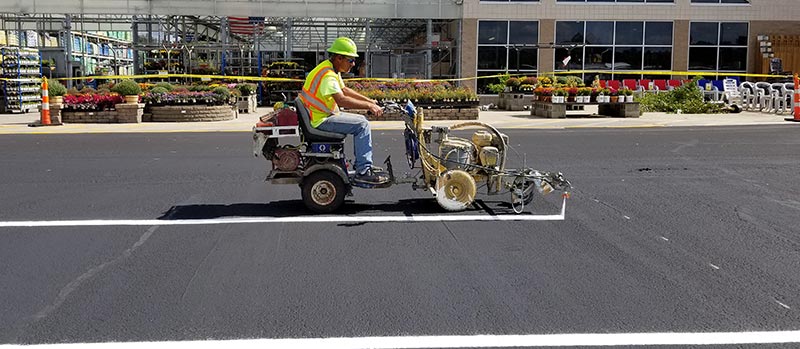A1 Professional Asphalt & Sealing Llc Fundamentals Explained
A1 Professional Asphalt & Sealing Llc Fundamentals Explained
Blog Article
The 9-Second Trick For A1 Professional Asphalt & Sealing Llc
Table of ContentsThe Best Guide To A1 Professional Asphalt & Sealing LlcA1 Professional Asphalt & Sealing Llc Fundamentals ExplainedExamine This Report about A1 Professional Asphalt & Sealing LlcA1 Professional Asphalt & Sealing Llc - TruthsA1 Professional Asphalt & Sealing Llc - Truths

The oil in a vehicle engine is not simply oil. The REOB contains all the ingredients that were in the waste oil as well as the wear metals from the engine (mainly iron and copper).
By making lots of blends utilizing different REOB samples and various asphalt binders, the variants greatly can be averaged out. Numerous States supplied examples of known REOB make-up to TFHRC researchers, who assessed the samples to contrast the percent of included (known) REOB to the found (checked) amount. The evaluations revealed an equivalent percentage of included and found REOB.
A1 Professional Asphalt & Sealing Llc Fundamentals Explained
None of those States understood that the asphalt they were getting included REOB. One State urged its examples had no REOB - https://dc-washington.cataloxy.us/firms/a1asphaltpro.com.htm.
Of the 1,532 examples checked, 12 percent consisted of REOB, and some consisted of substantially high degrees of it at 1020 percent. The greatest level was 34 percent in a sample from Texas, which TxDOT had utilized in a patching substance. This testing also revealed the presence of phosphoric acid in 11 percent of the examples, and 2 percent contained ground tire rubber.
Two years earlier at TRB's annual conference, the Federal scientists held an REOB workshop and presented the searchings for of their research laboratory analyses to a standing room-only crowd. Some agencies do not especially ban REOB, they do enforce physical tests that avert its useeffectively a ban. Others do not outlaw it by specification, however have agreements with asphalt suppliers to stay clear of the usage of REOB
Little Known Questions About A1 Professional Asphalt & Sealing Llc.
Ohio and Texas limit levels to less than 5 percent of the asphalt. To establish a reliable test method that all States can use, the TFHRC researchers established up a round-robin test strategy.
The participants are examining the examples separately utilizing the guidelines provided by the TFHRC scientists. The result will certainly be a recommended AASHTO test method that any kind of State can take on and utilize.
The sidewalk with REOB, which lies 0.6 mile (1 kilometer) from the pavement without REOB, has similar subgrade, web traffic density, and environment. However, the sector of Highway655 with 5 to 10 percent REOB showed substantial splitting. In this example, the existence of REOB was the recognized reason of cracking at a low temperatures.
"In our experience in copyright, even little amounts of 23 percent can be a trouble." An area of test sidewalk in Minnesota (MN1-4) discovered to have REOB likewise broke too soon. The pavement executed well for the very first 3 to 4 years, yet then started to fracture. This pavement is likewise based on low temperature levels.
A1 Professional Asphalt & Sealing Llc Things To Know Before You Buy
The tests were not considerable, but they you could try here showed that at levels of 6 percent or more, the tensile stamina of the asphalt dropped substantially. At a degree of 3.5 percent REOB, the variant in the physical examination methods was above the effect of REOB. In reality, it was difficult for researchers to examine whether REOB was present.

One binder specification taken into consideration is the difference between the reduced temperature vital spec temperature for rigidity (S) in the bending beam rheometer and the flexing beam rheometer creep slope (m-value) kept in mind as Tcritical. 2 independent study teams, one from AASHTO and the various other from the Asphalt Institute, ended that even more study is required on the use of REOB in asphalt.
Previously, all asphalt screening determined engineering residential or commercial properties such as stiffness. These tests do disappoint what materials had been contributed to the asphalt. One example obtained during the TFHRC study had a really unusual evaluation. The example had the following examination outcomes: Superpave PG 64-28 with a heat grade of 67.3 Tcritical on the bending beam rheometer was 6.7 degrees Celsius.

The 10-Minute Rule for A1 Professional Asphalt & Sealing Llc
These results demonstrate there are weaknesses in the standardized engineering testing methods that might be exploited. The manufacturer might have a financial advantage and the item passes all the standard examinations, however the product might not be useful to making sure long-lasting performance. To address this problem and the expansion of new asphalt additives and extenders, TFHRC is beginning a research study program to use handheld spectroscopic gadgets, x-ray fluorescence spectroscopy, and Fourier transform infrared spectroscopy to make it possible for analyses to be done in the area instead of having to take samples back to the lab.
Report this page